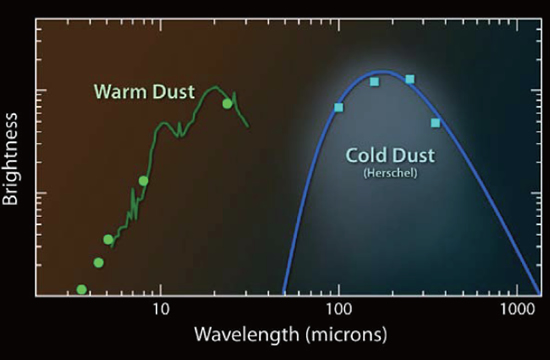|
圖片來源: M. Matsuura, E. Dwek, M. Meixner, M. Otsuka et al.

The infrared emission from supernova 1987A in the form of a spectral energy
distribution. The green points and line show observations obtained with the Spitzer Space Telescope, tracing the amount and composition of the warm dust in the supernova remnant. Although a clear signal is seen, only a relatively small amount of dust is needed to explain the emission. The blue data points show the detections obtained with the Herschel Space Telescope in the far-infrared. To emit at these wavelengths, the dust must be cold, and it also requires a large quantity of dust. The blue line indicates a model for the thermal dust emission, corresponding to 200,000 Earth masses worth of dust particles.
|
| Massive stars, with initial masses more than 8 times the mass of the Sun, do not end their lives with a phase of gradual mass loss, but in a rather more explosive way. Although they are heavier than the Sun, these stars shine brightly and burn through their huge fuel reservoir in a very short time, a
hundred to a thousand times quicker than our Sun. When the fuel is exhausted, the star becomes unstable, and explodes in a spectacular way. In 1987, such a supernova occurred in the Large Magellanic Cloud, which is a satellite galaxy to our own Milky Way. This was the nearest recorded supernova since almost four centuries, and provides an excellent opportunity to study the physics of
stellar explosions. Today, the supernova remnant is still clearly visible, and evolving. More than 20 years after the explosion observations with the Herschel space telescope revealed that SN 1987A, as it is known, has produced between a huge amount of tiny dust particles, adding up to about 200,000 times the mass of the Earth (Matsuura et al. 2011, Science, 333, 1258). The figure shows the
spectral energy distribution, on which the dust measurement was obtained; Masaaki Otsuka was part of the discovery team. The discovery helps to understand the origin of dust in the early universe. Dusty galaxies are found at a time that the universe is less than 1 billion years old. The short life time
of massive stars and the huge dust production in supernovae can explain the presence of large amounts of dust at such early times in the history of our universe. |
 asiaa.sinica.edu.tw 媒體連絡: epo
asiaa.sinica.edu.tw 媒體連絡: epo asiaa.sinica.edu.tw
asiaa.sinica.edu.tw